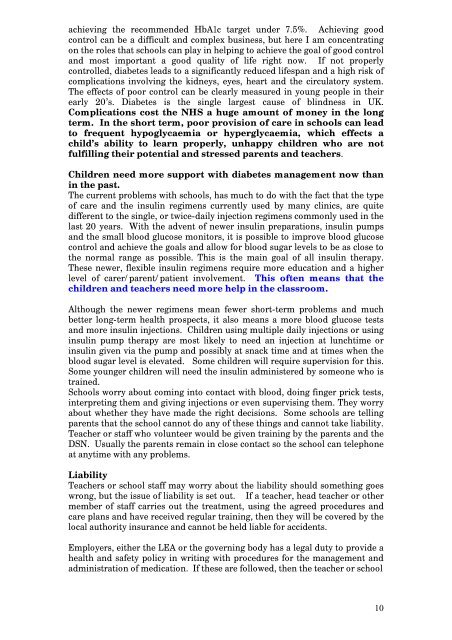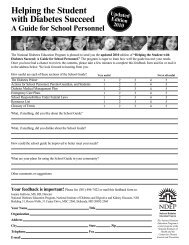Every Child Matters - Children with Diabetes
Every Child Matters - Children with Diabetes
Every Child Matters - Children with Diabetes
- No tags were found...
Create successful ePaper yourself
Turn your PDF publications into a flip-book with our unique Google optimized e-Paper software.
achieving the recommended HbA1c target under 7.5%. Achieving goodcontrol can be a difficult and complex business, but here I am concentratingon the roles that schools can play in helping to achieve the goal of good controland most important a good quality of life right now. If not properlycontrolled, diabetes leads to a significantly reduced lifespan and a high risk ofcomplications involving the kidneys, eyes, heart and the circulatory system.The effects of poor control can be clearly measured in young people in theirearly 20’s. <strong>Diabetes</strong> is the single largest cause of blindness in UK.Complications cost the NHS a huge amount of money in the longterm. In the short term, poor provision of care in schools can leadto frequent hypoglycaemia or hyperglycaemia, which effects achild’s ability to learn properly, unhappy children who are notfulfilling their potential and stressed parents and teachers.<strong>Child</strong>ren need more support <strong>with</strong> diabetes management now thanin the past.The current problems <strong>with</strong> schools, has much to do <strong>with</strong> the fact that the typeof care and the insulin regimens currently used by many clinics, are quitedifferent to the single, or twice-daily injection regimens commonly used in thelast 20 years. With the advent of newer insulin preparations, insulin pumpsand the small blood glucose monitors, it is possible to improve blood glucosecontrol and achieve the goals and allow for blood sugar levels to be as close tothe normal range as possible. This is the main goal of all insulin therapy.These newer, flexible insulin regimens require more education and a higherlevel of carer/parent/patient involvement. This often means that thechildren and teachers need more help in the classroom.Although the newer regimens mean fewer short-term problems and muchbetter long-term health prospects, it also means a more blood glucose testsand more insulin injections. <strong>Child</strong>ren using multiple daily injections or usinginsulin pump therapy are most likely to need an injection at lunchtime orinsulin given via the pump and possibly at snack time and at times when theblood sugar level is elevated. Some children will require supervision for this.Some younger children will need the insulin administered by someone who istrained.Schools worry about coming into contact <strong>with</strong> blood, doing finger prick tests,interpreting them and giving injections or even supervising them. They worryabout whether they have made the right decisions. Some schools are tellingparents that the school cannot do any of these things and cannot take liability.Teacher or staff who volunteer would be given training by the parents and theDSN. Usually the parents remain in close contact so the school can telephoneat anytime <strong>with</strong> any problems.LiabilityTeachers or school staff may worry about the liability should something goeswrong, but the issue of liability is set out. If a teacher, head teacher or othermember of staff carries out the treatment, using the agreed procedures andcare plans and have received regular training, then they will be covered by thelocal authority insurance and cannot be held liable for accidents.Employers, either the LEA or the governing body has a legal duty to provide ahealth and safety policy in writing <strong>with</strong> procedures for the management andadministration of medication. If these are followed, then the teacher or school10





